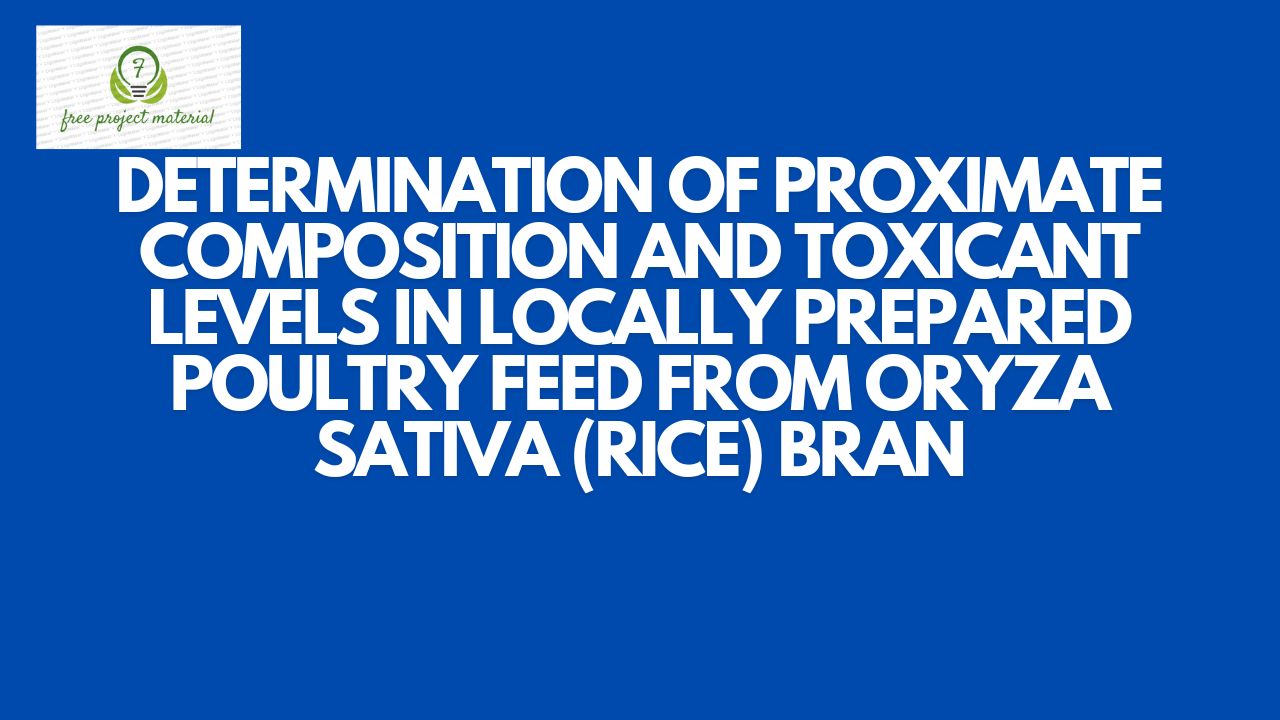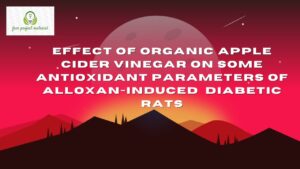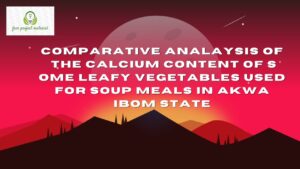ABSTRACT
This study analyzed basic nutrient in rice bran with special emphasis on proximate compositions. It also considered toxicant standards. Basic analytical techniques were used. The results showed that moisture content, ash contents, crude fiber, crude fat, crude protein, carbohydrates and caloric and value in the sample were 5.5±0.5, 9.95±1.7, 9.25±0.4, 3.25±1.06, 10.05±0.01, 67.45±1.78, 253.45±3.28, respectively. The toxicants were phytate (2.10±0.13), oxalate (3.54±0.06), Tannins (4.34±0.04), HCN (6.53±0.04). The results show that rice bran because of its proximate composition and toxicant levels can be used as an alternative source of energy in feed stock.
TABLE OF CONTENTS
Title Page – – – – – – – – – i
Certification – – – – – – – – ii
Dedication – – – – – – – – – iii
Acknowledgements – – – – – – – iv
Abstracts – – – – – – – – – v
Table of contents – – – – – – – – vi-ix
CHAPTER ONE
INTRODUCTION
1.1 Background of the Study – – – – – – 1-3
1.2 Aim and Objectives of the Study – – – – 3
1.3 Significance of the Study – – – – – 4
1.4 Scope and Limitation of the Study – – – – 4
1.5 Definition of Terms – – – – – – 4-5
CHAPTER TWO
LITERATURE REVIEW
2.1 Key Nutrients in Grain – – – – – – 6
2.1.1 Carbohydrates – – – – – – – 6
2.1.2 Protein – – – – – – – – 6-8
2.1.3 Lipids – – – – – – – – 8-9
2.1.4 Minerals – – – – – – – – 10
2.1.5 Vitamins – – – – – – – – 10
2.1.6 Dietary Fiber – – – – – – – 11
2.2 Key Nutrient in Animal Feeds – – – – – 11-12
2.3 Anti-nutrients in Rice – – – – – – 13
2.3.1 Phytate (phytic acid) – – – – – – 13-14
2.3.2 Oxalates – – – – – – – – 14-16
2.3.3 Tannins – – – – – – – – 16-17
2.3.4 Cyanogenic Glycosides – – – – – – 17-18
2.4 Use of Rice as Feed – – – – – – 18
2.4.1 Paddy Rice – – – – – – – – 18-19
2.4.2 Rice Straw – – – – – – – – 19-20
2.4.3 Hull and Bran – – – – – – – 20-22
2.4.4 Whole Rice Plant – – – – – – – 22-23
CHAPTER THREE
MATERIALS AND METHOD
3.1 Materials – – – – – – – – 24
3.2 Methods – – – – – – – – 24
3.2.1 Sample Collection – – – – – – 24
3.2.2 Percentage of Proximate Composition – – – 25
3.2.3 Determination of Moisture Contents – – – – 25
3.2.4 Determination of Ash Contents – – – – – 26-27
3.2.5 Determination of Crude Protein – – – – – 27-28
3.2.6 Determination of Crude Fat – – – – – 28-29
3.2.7 Determination of Crude Fiber – – – – – 30
3.2.8 Determination of Total Carbohydrate – – – – 30-31
3.2.9 Estimation of Caloric (Energy) Value. – – – – 31
3.3 Antinutrient Composition – – – – – 31
3.3.1 Determination of Phytate – – – – – 31-32
3.3.2 Determination of Oxalate – – – – – 32-33
3.3.3 Determination of Tannin – – – – – – 33-34
3.2.4 Determination of Cyanogenic Glycosides – – – 34
CHAPTER FOUR
RESULTS AND DISCUSSION
4.1 Results – – – – – – – – 35-36
4.2 Discussion – – – – – – – – 36-40
CHAPTER FIVE
CONCLUSION AND RECOMMENDATION
5.1 Conclusion – – – – – – 41
5.2 Recommendation – – – – – – 41
References
CHAPTER ONE
INTRODUCTION
1.1 BACKGROUND OF THE STUDY
Food and feed products of modern biotechnology are being commercialized and marketed in OECD member countries. The need has been identified for detailed technical work aimed at establishing appropriate approaches to the safety assessment of these products.
At a Workshop held in Aussois, France (OECD, 1997), it was recognised that a consistent approach to the establishment of substantial equivalence might be improved through consensus on the appropriate components (e.g., key nutrients, key toxicants and anti-nutritional compounds) on a crop-by crop basis, which should be considered in the comparison. It is recognised that the components may differ from crop to crop. The Task Force therefore decided to develop consensus documents on compositional data. These data are used to identify similarities and differences following a comparative approach as part of a food and feed safety assessment. They should be useful to the development of guidelines, both national and international and to encourage information sharing among OECD member countries. Rice is the seed of the monocot plant of the genus Oryza and of the grass family Poaceae (formally Graminae) which includes twenty wild species and two cultivated ones, Oryza sativa (Asian rice) and Oryza glaberrima (African rice). Oryza sativa is the most commonly grown species throughout the world today. Rice has been considered the best staple food among all cereals and is the staple food for over 3 billion people, constituting over half of the world’s population (Cantral and Reeves, 2002). Minerals like calcium, magnesium, phosphorus are present along with some traces of iron, copper, zinc and manganese (Yousaf, 1992). Rice is grown in all the ecological and dietary zones of Nigeria, with different varieties possessing adaptation traits for each ecology (Sanni et al., 2005). The two commonly cultivated varieties of rice in Nigeria are O. sativa and O. glabberim (Abulude, 2004; Adeyemi et al., 1986). Many varieties of rice are grown in Abakaliki and its environs. These varieties (such as Faro 14, Mass, Faro 52, Sipi, Awilo, Canada and so on) exhibit on cooking marked differences in quality. Attempts to correlate quality of rice with its chemical composition have not so far been successful. According to Sanjiva (1999), the differences in the quality of rice may be attributable to the difference in their colloidal structure; furthermore, these workers reported that the extent of swelling of any variety of rice during cooking could be used as index of its quality.
1.2 AIM AND OBJECTIVES OF THE STUDY
1.2.1 Aim:
The aim of the study is to analyze the basic nutrients base on the proximate and anti-nutrients on locally prepared poultry feed using Oryza sativa-rice).
1.2.2 Objectives:
To determine the proximate composition (protein moisture, ash content, crude fats, crude fiber, total carbohydrates, and caloric value) of Oryza sativa.
To determine the toxicant level of phytate, tannins, oxalate and hydrogen cyanide of Oryza sativa.
1.3 SIGNIFICANCE OF THE STUDY
Oryza sativa L. seeds of the poaeae family commonly known as Asian rice or simply rice could be considered as one of the most important grains since it is consumed by the half of the world’s population. It is an edible seed in tropical to worm temperature climates around the world and forming a staple food.
1.4 SCOPE AND LIMITATION OF THE STUDY
The study covers the determination of the proximate composition and antinutrient of Oryza-sativa. Due to lack of adequate facilities time and financial constraints.
1.5 DEFINITION OF TERMS
Proximate: proximate composition is the term used in the field of feed and food and means the composition of moisture, protein, crude fiber, crude ash, fat and carbohyrdates which are exposed as the content (%) on the sample respectively. Toxicants: toxicants substances that can block the absorption of nutrient into the body, decreasing the nutritive value of food.
Paddy Rice: can be defined as rice grain after threshing and winnowing and retain its hull.
Hull rice: can be define as the outermost layer of the paddy rice
Milled Rice: can be defined as the grain with renewed germ and outer layer such as pericarp, seed and part of aleulone layer by milling.
Parbolied Rice: hulled and milled rice processed from paddy rice or hulled rice which has been soaked in water and subjected to a heat treatment so that the starch is fully gelatinized, followed by a drying process.


